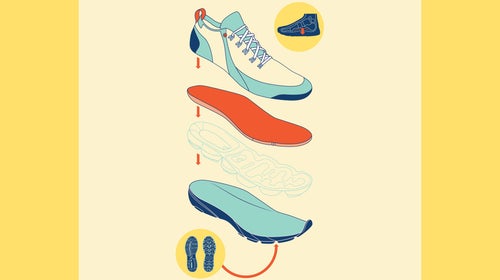Cushioning
Your first decision—even before thinking about fit or feature set—is whether you prefer a thick, deep-dish ride or a snappy, low-to-the-ground one. Lighter runners looking for efficiency and speed should steer toward a thinner (but not minimalist) shoe—usually less than 20 millimeters in the heel—while those who are slower, heavier, and more comfort oriented will enjoy a bit of cushion underfoot. But pay attention to where that foam is placed. Thin cushion in the forefoot delivers a more responsive ride; thick cushion yields a plush cruiser.
Drop
Heel drop—the height difference between the stack of foam in the heel and the stack in the forefoot—makes a huge difference in how well a shoe meshes with your particular stride. If you land on your heel, you’ll probably appreciate the thicker slab of foam in a shoe with eight to twelve millimeters of heel drop. Midfoot strikers, who land closer to flat-footed, will find a smoother stride in a shoe with zero to seven millimeters of drop.
Responsiveness
Some shoes feel like they’re equipped with wings. Others feel like down pillows. The joy of a soft midsole is plush, forget-the-road cushioning, but the trade-off is sluggishness—think running on dry sand. If speed and efficiency are what you’re after, you’re looking for a responsive ride: a midsole that’s probably on the thinner side, with just enough foam to let you move at full speed without needing to baby each step. It should feel snappy and energetic. Brands have their own proprietary foam compounds, with the attendant marketing-jargon names. The best way to determine if a foam is responsive enough for you is to try on a shoe and walk around in it.
Weight
Most training shoes weigh anywhere from seven to thirteen ounces for a men’s size nine, with the average being ten or eleven ounces. Just three ounces can mean the difference between a shoe that feels so-so and one that’s effervescent, like it floats through your stride. Lighter shoes tend to be thinner and forgo details like a rubber outsole (for durability) and protective features in the midsole and upper. So if you need more support when you run, don’t become too enamored with über-low weights.
Structure
Thankfully, the old superstition that what most runners need is a “stability” shoe—with attributes like a thick medial post and arch braces—seems to be fading. But a structured shoe can be a godsend for tired feet and heavier runners on big-mileage days. If you’re new to running, start with a slightly bulky, less flexible shoe. But if you like pushing the pace, you’ll be amazed at how liberating a flexy, lightweight shoe can be.
Upper
Speedsters may want to jettison all the optional comforts they can, but there are a few features that are worth their weight. A thick, pillowy tongue will prevent the laces from biting into the top of your foot, which can reduce blood flow. A heel counter—the plastic cup at the back of the foot—helps keep the shoe from feeling wishy-washy when paired with a thick midsole on upward-sloping terrain. A springy footbed and thick padding around the heel collar can take the sting out of each step.
Fit
We’re not just talking about avoiding hot spots or pinch points: a snug, well-fitting shoe will save a little bit of energy with every stride and make landings and toe-offs more efficient. You’ll know your shoe is too wide if your foot moves from side to side, if you see puckering in the fabric above your toes, or if you have to crank down on the laces to the point of numbness. You’ve nailed the fit when you can lace up, forget about your shoes, and enjoy your run.

